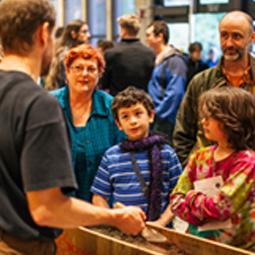[INTERACTIVE WALL NETTING WITH FRAME]
Many Gifts and Teachings Strengthen a Community
Contribute a reflection, feeling, or moment of gratitude you want to pass forward to your community
Contribute a reflection, feeling, or moment of gratitude you want to pass forward to your community
Generations of Teachers
"When we learn from someone who has dedicated their time and energy to transfer knowledge, it becomes our responsibility to teach those who are willing to learn.”
— Chepximiya Siyam Chief Dr. Janice George, Squamish
(Image Caption) Qw3 ’May Usia Tahnee Hawk Miller (right) and Ray Charlie from Chamismus, BC (left) in 2024 at a class in Tulalip, Washington.
“I grew up on the reservation since birth, but I was very sheltered. As I got older, I knew that I wanted to learn different cultural activities. So I took a weaving class with Susan Pavel in 2017 and made my first headband with her.
After that, I knew that I wanted to keep learning. There was something about just touching the yarn and the wool. I felt like this good, happy connection with it, and I had never felt that before.
It’s been different being on the other side of the weaving, being the teacher now. At first I was like, I don’t want to teach. I don’t want everyone to think I am here to know it all and teach everything. But I really enjoy both sides of it now. It keeps me going.
It feeds me.”
— Qw3 ’May Usia Tahnee Hawk Mille
[ANGLED CASE WITH SCREEN]
Many Hands Make a Weaving
The thing lately that keeps showing itself is how many people are involved in the weaving. And I shouldn’t say people: how many different spirits are involved in our weaving from start to finish.
From plants and animals to the comb maker, the source of the comb, the loom maker, the source of the loom. All the different ones.”
— Haʔməkʷitən Kelly Sullivan, Port Gamble S’Klallam
Touch the screen
Reveal the web of beings that help bring weavings into existence.
[SCREEN TEXT]
Weaver
"To weave something is to allow the Ancestors to work through your hands."
Weavers bring the community together, weaving protection and wealth for their people.
Yarn Spinner
Spinners create spun yarn from raw material gathered from plants and animals. This transformative power is part of the wealth that weavers’ gift to their communities.
Gatherers
“Always be listening; you never know when you will receive a teaching from a tree or plant.”
All gatherers balance making sure there is enough left behind with never coming home empty handed.
Tool/Loom Maker
Many tools are needed during the weaving process. Tool makers know the tools will be used in a sacred practice, and often use spiritual imagery to make the tools stronger.
Wool Dyer
“Color speaks its own language.” The wool dyer’s job is to listen, and to understand that language. Dying can be experimental; different materials, temperature, and time will create different results.
Mountain Goat
In winter and spring, these woolly goats move from high peaks to lower elevations to keep warm and find food. During this time their wool can be gathered for weaving.
The Weaving Itself
Weavings themselves can be teachers. They have a life of their own. The many hands required to produce a weaving speak through them.
Teachers
Teachers pass on more than specific weaving methods. They show students how to rely on the materials and each other, and how students each bring something unique to the work.
Wearer
The wearer is an important part of the life of a weaving. They may use the weaving for protection from rain or cold, or for ceremonial or spiritual purposes.
[LARGE WALL PANEL]
